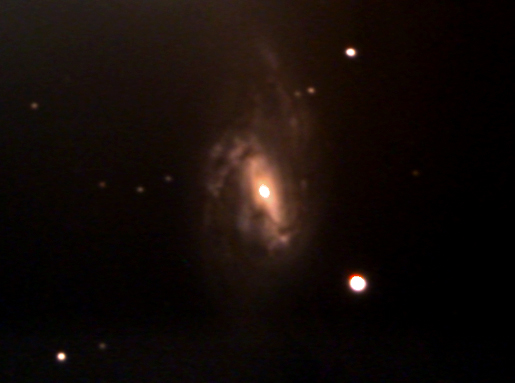
M66

RA: 11hrs 20min 12secs Dec: 12º 59' 00" Mag: 8.9 Distance: 30 million light years Constellation: Leo
One of a group of three galaxies clustered just south of the constellation Leo, the 'Leo Trio' (including M65 and NGC 3628) was discovered by Méchain in 1780 working in collaboration with Messier. The grouping is real and all three galaxies lie 30 million light years away. M66 is classed as an Sb Spiral galaxy and is viewed from almost face-on where the bar can be seen with its dark-dust trails which have been disrupted somewhat by its proximity to the strong gravitational influences of M65 and NGC3628.
This photo was taken on a rare clear night in an otherwise cloudy and overcast Spring, on the night of the 3rd April 2005 with the moon in its first quarter. There was no wind and seeing quality was good. If your monitor is set on the bright side, you will see that the sky background is polluted with excessive signal 'noise' on the top edge of this picture and around the galaxy. I updated Meade's Autostar Suite to ver 3.23 and Autostar Envisage (whch runs the DSI) to ver 5.85 which changed some of the settings in the programme when I came to use it this night. One of the changes was that the process of dark-subtraction was not selected where it had been the default previously. I didn't realise this until the following night when taking pictures of M96, so pictures of both M65 and M66 were of poorer quality in signal-to-noise ratio.
Once again, the exposures were set at f6.3 and this picture is the sum of 4 exposures in series of 21.2 seconds by Envisage (636 seconds, 212 seconds, 441 seconds and 987 seconds) making a total exposure time of 38 minutes. As with the photo of M65, the main processing efforts were exerted on the signal noise in the background. The galaxy was selected out carefully in Photoshop wth a feather of 30 pixels (more difficult than with M65 because of the irregularity of the galacy outline) and the background was darkened selectively in the curves command for each individual RGB channel. Midtone enhancement was carried out under a layer-mask of the inverse of the image to prevent the stars and the galaxy core from becoming over-exposed and 'blooming'. If the sky around the galaxy and in the top half of the picture is too 'noisy', turn down the brightness and adjust the contrast of your monitor.
HOME PICTURES: Deep Sky PICTURES: Solar system PICTURES: Wide field